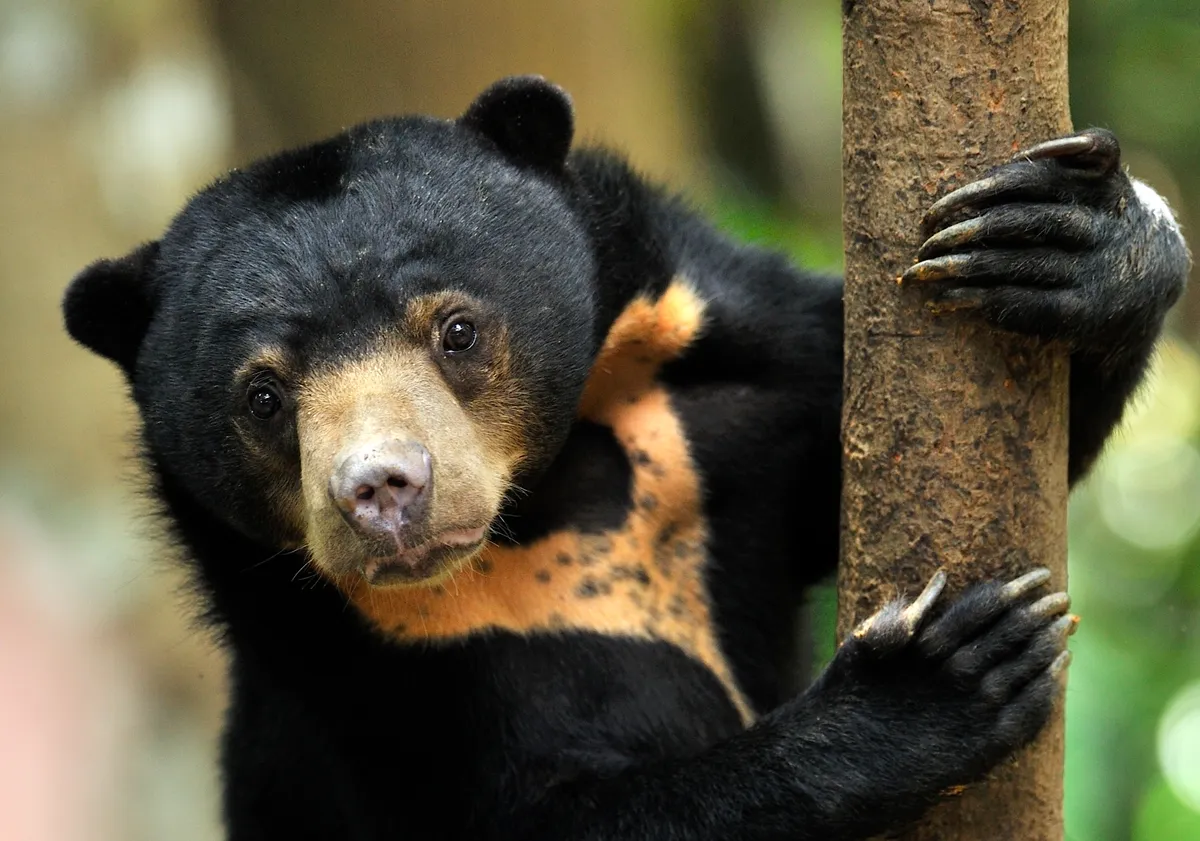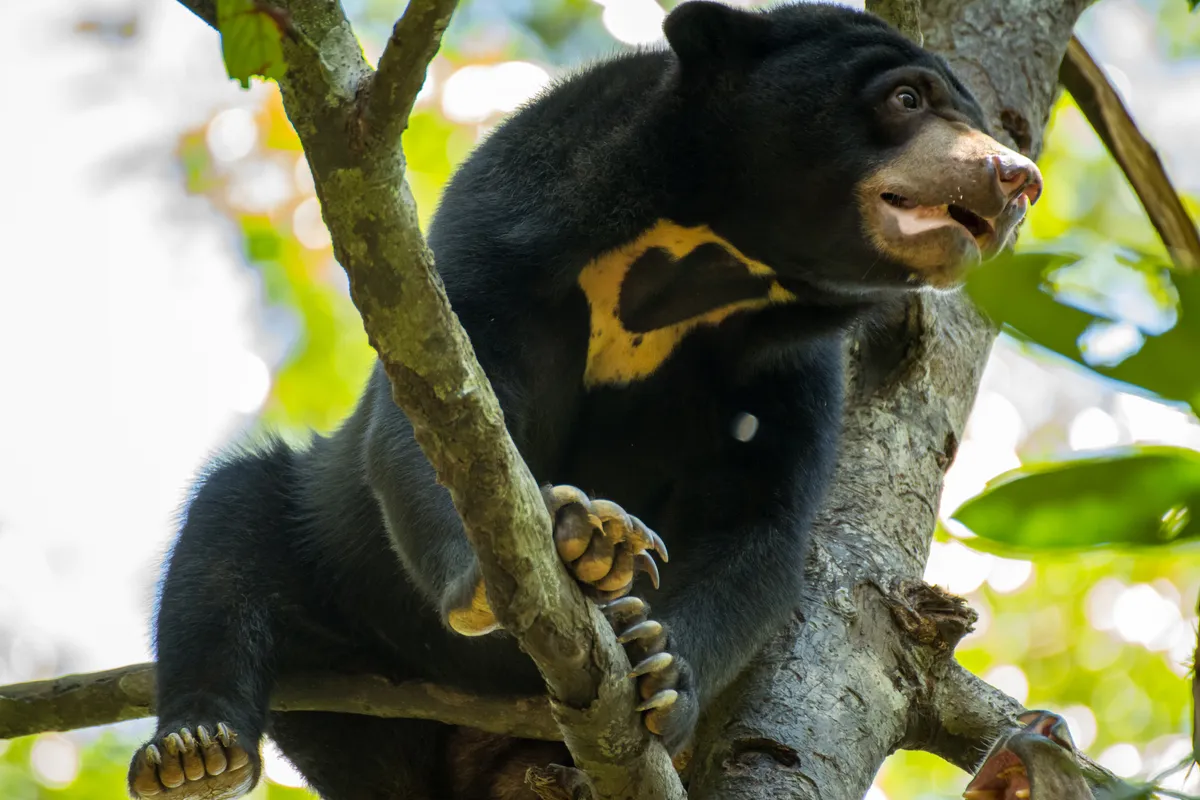The elusive sun bear, the least known of all eight bear species alive today, faces a number of threats, says Heidi Quine from Animals Asia – learn all about sun bears in her expert guide.
Where do sun bears live?
Sun bears were historically found in forests and shrublands in warm and humid climates, from China in the north (where their continued existence is uncertain), Borneo and Sumatra in the south and east, and India and Bangladesh in the west. Soberingly, sun bears now occupy just 32-40% of this historical range, and the species is at risk of extinction unless urgent conservation actions are taken.
Sun bears are sympatric with Asiatic black bears (or moon bears) across most of Southeast Asia, meaning they occupy much of the same territory. Healthy forests can support both bear species, as the smaller sun bear consumes a proportionally higher volume of insects in their diet, reducing competition over favoured wild forest fruits.
Why are they called sun bears?
Sun bears are named for the bib of often sunshine-yellow fur adorning their chests. Each sun-bear bib is unique and can be used to distinguish one bear from another. Their fur is thick, short and generally jet-black, although some bears have a reddish or silvery hue.
Despite their name, recent research on wild sun bears suggests these animals are crepuscular, meaning their activity levels peak during the twilight hours of dawn and dusk.
How big are sun bears?

The smallest bear on Earth, sun bears are only around half the size of an American black bear, measuring 4-5 feet tall when stood on their hind limbs, and weighing up to 68kg.
There is only one sun bear species, though the island of Borneo has a recognised subspecies, a small bear of between 25 kg (females) and 40 kg (males).
Relative to their skull size, sun bears have the largest canine teeth of any bear species. For context, sun bear canines are the same size as those sported by polar bears, an species some 5 to 10 times larger.
Sun bears have long, curved claws, are well adapted for gripping bark and are the most arboreal of all the bear species. These bears will climb trees to forage for wild fruits and beehives and to evade predators such as tigers, leopards and dholes, an Asian canid. One of the characteristic signs of the presence of wild sun bears is claw marks on trees they have climbed.
What do sun bears eat?
Sun bears are omnivorous, favouring fruits, insects, small animals and bee nests (for insects and honey). Large teeth and long claws enable sun bears to tear into logs and termite mounds in search of insects, an important component of their diet. Sun bears also have long tongues, which can extract honey and insects from hives and logs. Their tropical habitat generally provides food resources year-round, so sun bears do not hibernate.
A keystone species, sun bears have been called forest engineers because of their crucial role in nutrient cycling, seed dispersal and regulating insect populations. In digging for wood-boring insects, sun bears create cavities that can be used as habitat by other species, such as hornbills, which use the holes for nesting.
Comparatively little is known about sun bear reproductive and social behaviour, partly because they are elusive and avoid humans. However, exciting research from the University of Portsmouth in 2019 found that, like humans and gorillas, sun bears engage in facial mimicry.
In humans, facial mimicry is understood as a way to acknowledge the emotions of others, although the underlying functional mechanism still needs to be fully understood. In sun bears, this facial mimicry or mirroring behaviour may be a way to signal to one another the desire to play in particular ways or to strengthen social bonds between bears.
What are the main threats to sun bears?

The biggest threats to sun bears are deforestation and commercial hunting, with a worryingly synergistic relationship between the two; as wild habitats shrink, sun bears are forced closer to human settlements and are therefore at greater risk of being hunted.
The fragmentation of forests due to both legal and illegal logging, as well as the extensive expansion of palm oil plantations, has led to the division of bear habitats and a decrease in the viability of wild sun-bear populations. Sun bears are especially vulnerable to the effects of changing forest compositions, as they rely on fruits, which are generally found in established forest canopies. Sun bears can and will supplement their wild diet with palm fruits growing in palm oil plantations. However, these monoculture crops do not provide the nutritional diversity or forest cover that sun bears need.
Commercial hunting of sun bears is partly driven by demand from the illegal exotic pet trade. Born weighing just 300 grams, young sun bears look similar to dogs. This is perhaps reflected in the Vietnamese name given to the bear - gấu chó - which, when translated literally, means dog bear.
Wild nursing mother sun bears, if found by poachers, are often killed and their cubs taken. While the mother's body parts are sold at wild meat restaurants and in traditional Asian medicine, the cub is trafficked into the global, multi-billion-dollar exotic pet trade. The exotic pet trade is organised crime, with sophisticated networks of poachers, traders and dealers exploiting weak law enforcement using social media to advertise, where they can run multiple anonymous profiles and evade detection by the authorities.
The wild meat and traditional Asian medicine trade also threatens sun bears. In Vietnam, most wild meat is consumed in restaurants rather than in private homes. A 2021 survey conducted by WWF and GlobeScan across Vietnam, Thailand, Japan, China and the US revealed that 7% of respondents stated that they or someone they knew had purchased wild meat in wildlife markets in the preceding 12 months. Wild meat is often consumed to show social status or wealth.
Meanwhile, sun bears are also farmed for their bile in Vietnam. Although sun bears are significantly less common on bear bile farms than moon bears.
The good news is that decimated wild bear populations can recover. Monitoring in Indonesian Borneo of a sun-bear population reduced to nearly zero by a forest fire showed the population recovering to 65% of the level of nearby populations in just ten years.
The IUCN (International Union for Conservation of Nature) lists the sun bear as vulnerable, with global populations in rapid decline and losses of 30% of the world's sun bear population in the last 30 years alone.
Discover more bear species
- Spirit bear facts you need to know
- Grizzly bear guide: where they live, how they hunt and conservation
- Black bear guide: how to identify, where to find them and what to do if you encounter one
- Polar bear guide: where they're found, what they eat, and why they're threatened
Heidi Quine is Animal Asia's Vietnam Bear and Vet Department Director and heads up the bear care and veterinary department at Animal Asia's Vietnam Bear Rescue Centre. The charity has two bear sanctuaries, one in Tam Dao National Park and one in Bach Ma National Park.
Animals Asia is devoted to ending bear bile farming and improving the welfare of animals across Asia. They promote compassion and respect for all animals and work to bring about long-term change.
For more information about Animals Asia’s work, please visit animalsasia.org
Images: Getty Images
